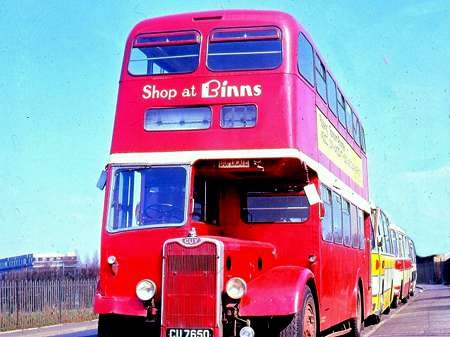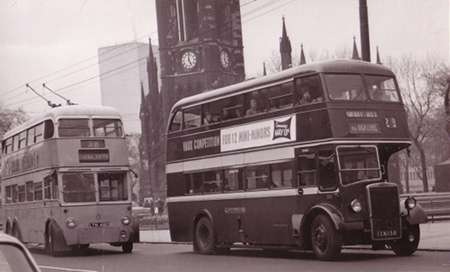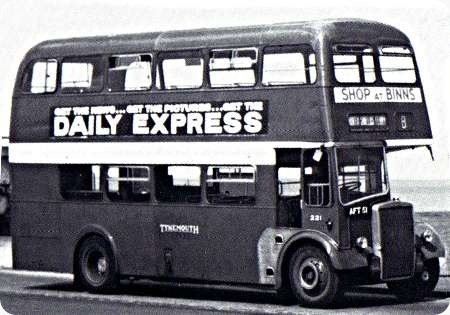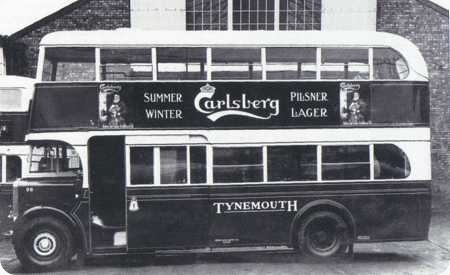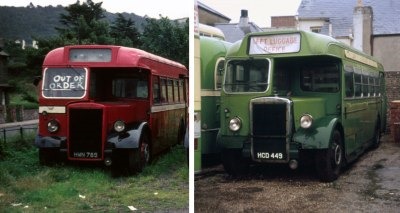Tynemouth and District – Guy Arab III – FT 7388 – 188
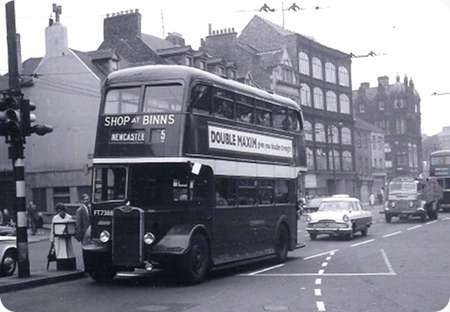
Photograph by ‘unknown’ if you took this photo please go to the copyright page.
Tynemouth and District
1952
Guy Arab III
Weymann H30/26R
On the last leg of its journey from Whitley Bay St Mary’s Island to Newcastle Haymarket, this 1952 H30/26R Weymann bodied Guy Arab III was one of ten in the NGT Tynemouth and District fleet; FT 7381/90 181/90. When new the livery would have been the same as the two Regent’s and the Pickering Arab featured elsewhere on this site. The interiors of these sturdy well built bodies were finished to a very high standard, they were double skinned throughout, the lights had glass covers with chrome bezels and the area around the window’s was finished off with polished wood surrounds. As with all of T&D vehicles of the period, the seat cushions and backrests were upholstered in a rather attractive dark red moquette, the backs and cushion edges were trimmed in leather. Percy Main’s first 8ft wide buses, they were also the first with sliding cab doors, but they were a heavy beast and lacked many of the creature comforts we now take for granted. No heaters or power steering, they had a crash box and the brakes could best be described as adequate. They were fitted with the almost indestructible Gardner 5LW and breakdowns were extremely rare, but they were anything but fast, and these days they would be underpowered and would struggle to keep pace with traffic, but they could scale the North Face of The Eiger ‘metaphorically speaking’. I was 6 in 1952, so in my youth I must have clocked up quite a few passenger miles on these, but they were withdrawn in 1966 so I never drove one on service. However, one vehicle in particular was to play a significant part in my life; at the tender age of 21, in January 1967 I started my driver training at Percy Main and passed my test two weeks later, the training vehicle was 189 and the instructor was a chap called Jackie Gallon. He taught me how to start off using the clutch, then go through the box from 1 to 4 and back to 1 just by listening to the engine ‘no rev counters in those days’ the object of the exercise was to keep the engine in tune with the gearbox, and done properly the gears would just fall into place as smooth as silk, but get it wrong and everyone within a radius of 100yd’s would hear about it. Once you’ve mastered the technique you can get a quick change down on a hill that would rival any other gearbox I’ve ever encountered. The early Orion bodied Arabs that followed these were stripped to the bone to achieve lightness, but they were an unpleasant vehicle to be on as you were subjected to a constant barrage of knocks bangs rattles and squeaks, and the interiors looked cheap and chatty in comparison. I know of some similar Weymann bodies have survived, but I’m not aware of any on a Guy chassis.
chassis.
As a footnote, If you look behind the bus, going in the opposite direction is what looks like the rear of a MK 3 Zodiac, so the photo cant be earlier than 1962, but by the layout and style of the Shop At Binns logo, I would say it was about 1964.
Photograph and Copy contributed by Ronnie Hoye
24/03/13 – 15:09
Another gem from Ronnie! I note his comments about learning to drive a bus. Crash box? My first experience of driving a bus was on one of the Hampshire Bus (ex Wilts & Dorset) FLF trainers. That had a crash box. Going up was easy but, for coming down, I was told to make sure the speedo was showing precisely 20 for 4 to 3, and precisely 12 for 3 to 2. 1 was used only for hill starts. A chap at what was then Southampton Citybus was telling me one day that his instructor had said double declutching is for amateurs – if you listen to the engine, you can go straight through. This ties in very nicely with Ronnie’s comment about being in tune, and it ties in with what others on this site have said about the rear engine!
Pete Davies
24/03/13 – 15:10
Looking at the main photo and reading the text I was convinced the photo was indicative of Tyneside as I knew it when visiting in 1958/9. Then I saw Ronnie’s blow up inset and his comment about the Zodiac which is quite correct.

Apart from the Commer C series Mk2 (I can hear "the Knocker" as I type!) in front of what is presumably a PD2 (whose?) there is, at the extreme left, the front wing of a Sunbeam Rapier distinguishable from its Rootes Group contemporaries by its wheel embellisher.
A very atmospheric photo of a time now almost half a century ago.
Phil Blinkhorn
24/03/13 – 16:47
Phil, the PD2 is one of Gateshead’s, they had the Newcastle Corporation destination layout rather than the standard NGT. The livery was a dark chocolate with cream centre band and also under the lower saloon windows, it was outlined in black and they had black wings. they looked superb, but it tended to fade rather quickly, and that made them look a bit drab.
Ronnie Hoye
24/03/13 – 16:48
With regards this posting by Ronnie of a Tynemouth Guy FT 7388, in which he mentions later, lightweight Orion bodies, not sure whether any had survived on Guy chassis.
Well, here is one that did, if only for a little while, seen here on some works contract when I stumbled across it in the Bromford Bridge area of Birmingham, one afternoon in the late sixties when I was working in that city. I recall it had the remains of “Northern” fleet names rather than Tynemouth, but it is the only shot I have of an Orion body on an exposed-radiator Guy chassis. I had always thought it was perhaps a rebodied older bus, a Utility even, perhaps not.
Rob Hancock
24/03/13 – 17:13
A superb photograph and wonderful commentary. To pick-up Phil’s point about the PD2 I would hazard a guess that the destination layout is that of Gateshead and District, but I am open to correction here.
Kevin Hey
This is all there is I’m afraid
24/03/13 – 17:40
Thanks Ronnie and Kevin for reminding me of Gateshead and District, especially of the livery, of which I’d all but forgotten. The number of operators in the Newcastle area with interestingly different liveries always made a visit worthwhile.
I also note in the latest inset shot confirming my Sunbeam Rapier identification, the rear of a 1956 Vauxhall Cresta, though the owner saved money by not opting for the contrasting second colour flash!
Phil Blinkhorn
25/03/13 – 07:53
Yes, thanks Ronnie for confirming the destination layout on the PD2. It had never crossed my mind that Gateshead and District motorbuses had Newcastle Corporation-style destination indicator layout, well at least until the 30ft Titans and Atlanteans were taken into stock. The Newcastle destination layout was in fact the same as Huddersfield Corporation. This was introduced at Newcastle when Harry Godsmark became General Manager having previously been at Huddersfield. In the municipal sector there are quite a few examples of general managers introducing revised destination layouts to their new fleet based on the arrangements at their previous undertaking. The move by John C. Wake from St. Helens to Bradford is one example of this, although strangely he did not take the arrangement with him when he moved to Nottingham.
As Phil says the Tyneside area was always worth visiting on account of the various operators.
Kevin Hey
25/03/13 – 07:53
Phil, the Rapier is also a convertible. Quite rare, especially in northern climes!
Perhaps a little more commonly seen amongst Southdown Arab III’s, for example.
Eric Bawden
25/03/13 – 10:30
Absolutely Eric!
Phil Blinkhorn
25/03/13 – 15:03
Ronnie Is this photograph taken on the Gt North Road at Barras Bridge? The dotted white line on the roadway curving to the lower left of the photograph is intriguing. Was this a guide line for drivers of Corporation trolleybuses, I wonder?
Phil/Eric If I only had my old copies of Observer’s Book of Automobiles! These books were superb for identifying cars and the variants!
Kevin Hey
25/03/13 – 15:58
Could be a clip from the 1961 film Payroll starring Michael Craig and Billie Whitelaw.
Roger Broughton
26/03/13 – 06:50
Yes, Kevin, the photographer would be standing with His/Her back to the South African War Memorial, if the bus had kept to the left it would have gone down Northumberland Street, which at that time was still the A1.
Phil, I knew I had a photo of one somewhere, it would have been taken from about the same place as the one of the Guy, but facing to the right. I think Gateshead had around 33 of these splendid all Leyland PD2’s, they were a mixture of both 8ft and 7ft 6", the later were for services over the High Level Bridge which at that time had width restriction, the Trolleybus is one of 70 similar to the London Q’s, this is one of the first batch of 20, the remainder had the same destination layout as the Leyland
Ronnie Hoye
26/03/13 – 06:51
Yes Kevin, I also had a couple of editions of the Observers books and whilst they did come in handy they also listed many Russian and other Eastern Bloc cars that you would never see on British roads, as well as many US and Australian cars that were unlikely to grace our highways. Happy days though!
Eric Bawden
26/03/13 – 06:51
Yes this is Barras Bridge between the university and the bus station.I worked at the then new Civic Centre, just opposite, in 1970-73 just as the area was trashed by the central motorway.So I was familiar with this scene and there were still a few interesting buses about, though sadly the trolleybuses were long gone.
David Rhodes
26/03/13 – 06:52
As a Weymann fan, especially this classic design, how many of you (like me) noticed that this is a 27′ long bus with longer rear upstairs windows. I think it makes a good design even better (balance and integrity). Morecambe had at least one Regent III like this (which I believe is preserved), Devon General had a number (one of which is reserved ?). How many more were there at 27′ – I don’t count the Bury examples because they were a transition to the Aurora and had a mix of designs?
David Oldfield
26/03/13 – 08:13
Thanks for the PD2 photo Ronnie. Re the trolleybus, I well remember these because, apart from visits with my Father when he was working, he had cousins in Walker and Denton. My earliest memory of those is of staying in an hotel in, I think, Denton with the trolleybuses parked in front.
Presumably this was the Denton terminus. As this was 1953 and I was around 6 at the time, the memory is hazy.
Phil Blinkhorn
28/03/13 – 10:53
Hard to imagine a better-looking bus than this very welcome posting of Ronnie’s. The dead-vertical, straight-sided radiator means business and the Weymann body looks as if had been sculpted from a block, rather than put together piece by piece. Before David O’s comment I hadn’t noticed that it was 27′ long. I don’t know how long these buses were in service, but with Guy-Gardner-Weymann quality they must have had a potential lifespan of 40-odd years. It’s a pity that changing needs and fashions cause such wastage.
Ronnie Hoye and Pete Davies’s mention of clutchless changes remind me of a day in 1968 when this trickery came in very handy. I was doing a short, quiet but hilly Thames Valley working northward from Reading to the Unicorn Inn at Kingwood Common, when at the bottom of Prospect Street, Caversham, the clutch pedal went to the floor. Luckily the Lodekka had a very nicely-mannered AVW engine with an extremely precise pump and no backlash in the transmission, so I reckoned that with the conductor’s permission we could soldier on, using the starter to get us rolling in first gear after each stop. He agreed and rang through to Lower Thorn Street to warn them that a replacement bus would be needed later.
Coming up to each stop where there was anyone to get on or off I dropped her into first for the last few yards and slowed to about one mph, and to our relief most people hopped on and off in paternoster-lift fashion. For old folk, of course, we came to a proper halt and restarted on the button. Not being able to change up out of first till the top of any real hill was an embarrassment, though on gentle slopes you could get up into second and beyond without risking a jerk.
I can’t remember whether we did the same on the way back, or whether they sent the replacement up to meet us. I’m grateful to a co-operative conductor and a beautifully-engineered vehicle for making possible an antic I wouldn’t dream of risking today!
Ian Thompson
 Vehicle reminder shot for this posting
Vehicle reminder shot for this posting
29/03/13 – 06:52
I once had a Fiat Uno whose clutch cable snapped. I drove it from my home in Chipping Sodbury to the garage in Bristol in the manner described by Ian – a bit hair-raising at times (with that gearing the starter would not have coped with any sort of gradient) but great fun. There are times when knowledge of crash gearboxes is very useful, even when you aren’t using a crash gearbox!
Peter Williamson
30/03/13 – 10:04
The very early Atlanteans we had at Godfrey Abbott (ex Ribble) were not fitted with an interlock on the gear change, it was perfectly possible, and by no means unusual to accidentally change down from fourth to first!! A sound that was like no other, before or since!!
Some of the early semi’s had a ring of differing colour round the speedo to show when to change gears. This device could also be seen on Leyland/BUT engined DMU’s of similar vintage (could the connection be "Self Changing Gears"? of which W. A. Stanier of duchess fame was a director)
Another excitement was with NCK 352 which used to stick on or about TDC, this bus had a large pair of Stilly’s as standard equipment! open bonnet, apply to nut on end of crankshaft, pull hard, then restart!!
Pete Bradshaw
Quick links to the - Comments Page - Contact Page - Home Page
